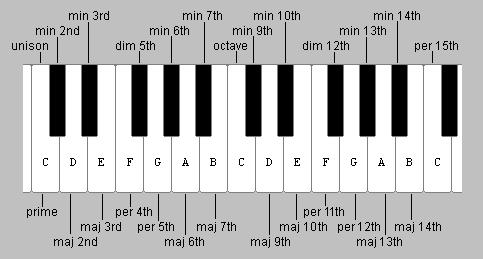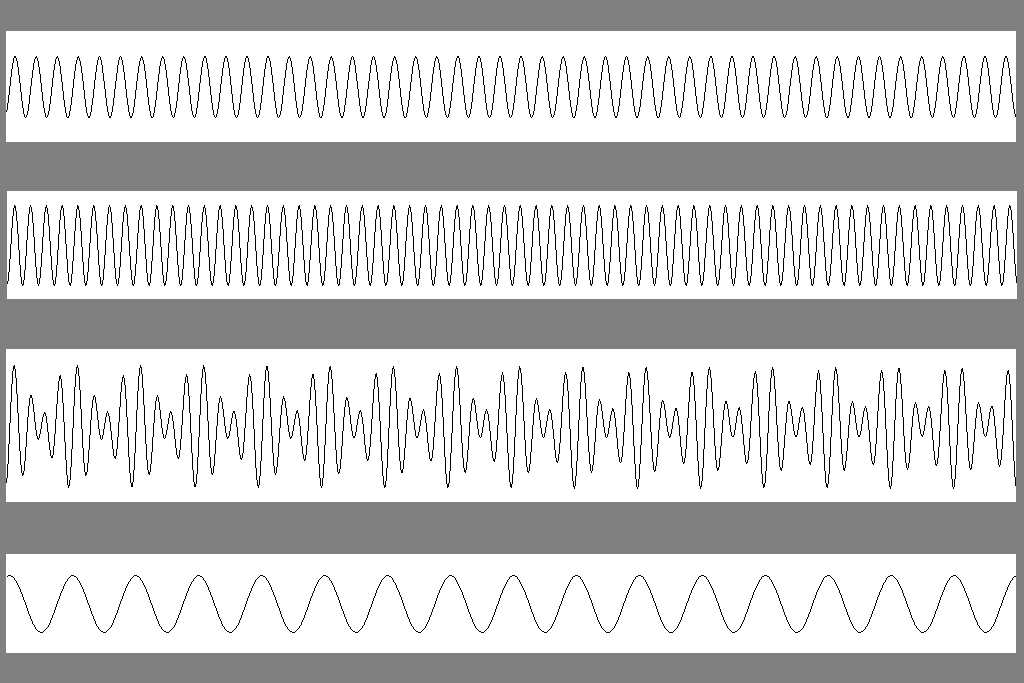 |
Interval
Separation in pitch between
two notes, or the two
notes sounded together; sometimes called a dyad. It is a
fundamental component of scales and chords.
The basic method for describing intervals is ordinate to the degrees of the diatonic scale.
|
Press any adjacent label button to hear what the interval sounds like. |
The general method for describing intervals results from analyzing difference between the major and minor scales.
| Here are the written forms of these scales with C as tonic for comparison: |  |
 |
| Press button to hear scale: | ||
| For further illustration the piano keyboard provides consistent interval distance through all half-steps: |
 |
 |
This comparison ultimately leads to this generally accepted convention for describing intervals:
Extending this nomenclature across octaves using C as prime reveals more generally:
 |
Intervals may also be called by more than one name, which helps in generally describing melodic and harmonic relationships concerning scale_degrees and modes. Here is a table showing common and alternate (not exhaustive) interval names:
| Halfsteps | Common name | Alternate name |
| 0 | unison | diminished second |
| 1 | minor second | augmented first |
| 2 | major second | diminished third |
| 3 | minor third | augmented second |
| 4 | major third | diminished fourth |
| 5 | perfect fourth | augmented third |
| 6 | diminished fifth | augmented fourth |
| 7 | perfect fifth | diminished sixth |
| 8 | minor sixth | augmented fifth |
| 9 | major sixth | diminished seventh |
| 10 | minor seventh | augmented sixth |
| 11 | major seventh | diminished octave |
| 12 | octave | diminished ninth |
| 13 | minor ninth | augmented octave |
| 14 | major ninth | diminished tenth |
| 15 | minor tenth | augmented ninth |
| 16 | major tenth | diminished eleventh |
| 17 | perfect eleventh | augmented tenth |
| 18 | diminished twelfth | augmented eleventh |
| 19 | perfect twelfth | diminished thirteenth |
| 20 | minor thirteenth | augmented twelfth |
| 21 | major thirteenth | diminished fourteenth |
| 22 | minor fourteenth | augmented thirteenth |
| 23 | major fourteenth | diminished fifteenth |
| 24 | perfect fifteenth | augmented fourteenth |
When comparing notes for intervals generally we are considering the sustain portion of the sound made by the instrument, as in this example image of a note waveform which we might observe on some scope:

Assuming indefinite sustain (without decay), we merely add the waves together to arrive at the combined waveform of the interval. In this next example we show (a) fundamental, (b) wave representing its perfect fourth, (c) summative waveform, and (d) observed beat-frequency waveform:

The significance of the beat-frequency becomes more apparent when comparing dissonant notes. The next image shows combined (summative) wave for a minor-second interval with its beat-wave highlighted:

This highlighted wave may be heard as a sort of pulse, and may frequently be used as a key factor in rates of vibrato, tremolo, or as a fundamental component underlying the rhythm of the musical work.